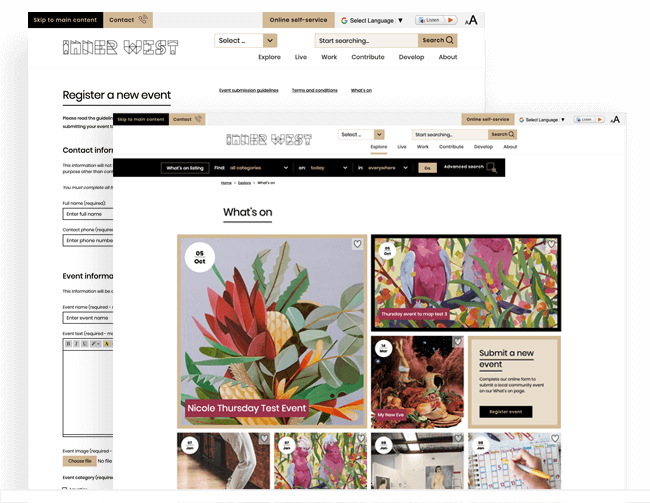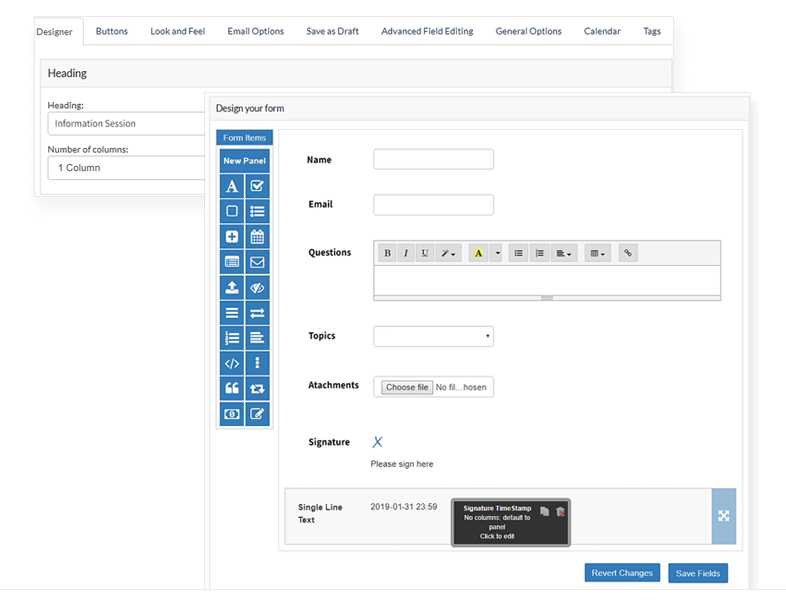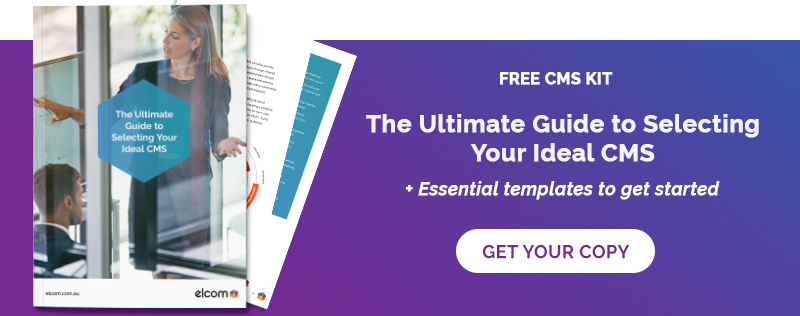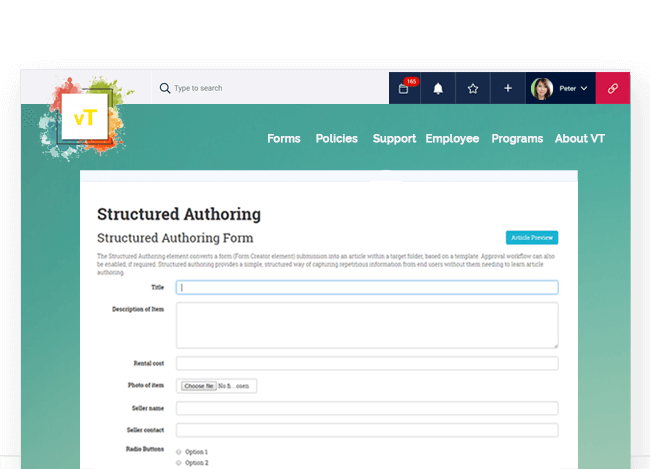Enterprise web content management solutions (CMS) allow users to easily create, manage and deliver information to your internal and external audiences, and can be structured in any number of ways to suit the organisation. Once you decide why your business needs a content management system, it's time to decide on what functionality you want. There are a handful of features that can be underappreciated, yet prove invaluable to businesses and increase CMS ROI significantly.
Did you know that the right enterprise web CMS platforms can enable you to carry out the following seven actions?
1. Create a Website, and an Intranet, and an Enterprise Portal
We often have organisations engage us in a new website project to attract customers, or a new intranet for their staff, or a new portal project to connect their customers and other external stakeholders, such as partners or suppliers. Quite often, they aren’t aware that a single web CMS can be used to achieve all of these things, improving a significant number of business processes across your organisation.
The beauty of a web CMS is at its core, it enables you to manage and deliver content online, and that can take many different forms. While these solutions look different and are built for different end users, they all share common functionality such as content publishing, document management, image management, forms and workflows, security and group permissions, search functionality and more.
Why is this beneficial over choosing a platform that can only build one type of solution?
- Simplify site administration
- Easier for publishers and for trainers to train publishers
- Economies of scale from deploying sites from one platform
- Deliver great experiences to internal and external stakeholders, from staff and suppliers to customers and members, from one platform.
Bonus: Need to train your staff? Some CMS platforms allow you to add on a learning management component to easily train staff in various locations online.
Further reading:
2. Plan Events and Meetings Easily
It’s natural to expect to use a web CMS to manage content and documents. But many people don’t expect that they can organise public and private events easily through the web CMS platform as well.
The right platform will enable you to invite people to your event, take credit card payments for tickets, send out SMS reminders, set up event alerts and more.
With a solid events manager, organisations are able to push updates to audiences as desired and even track which who attends which events. Events can also be submitted via the community from employees and customers depending on the solution. For example, the Inner West Council enables community members to post their own events on their website through an online form, which is then approved or rejected by the Inner West digital team with a few clicks of a button.

A Meeting Manager tool allows you to carry out a similar function within the business for internal meetings, so you can easily schedule a meeting, upload meeting packs and assign agendas.
3. Build Secure Forms and Smart Workflows
Online forms and workflow automation makes life a breeze for teams. Online forms can make it incredibly easy to collect information for feedback, quotes, HR policies, applications and more. A web CMS often has a form creator that allows you to drag and drop fields such as signatures, panels and if/then fields, as you need them to create a form in minutes, without any need to learn about article authoring.

It’s also simple to submit your new forms and other work for approval from specific people within the organisation. HR, marketing, accounts and just about every other department will be delighted. Automated workflows route form data to managers and other appropriate employees. The power of forms and workflows for intranets, portals and websites is that they can be designed and set up to suit the organisation and its various departments. Workflows use rules to enable them to adapt according to form answers or user profile.
For example, Northcott, one of Australia’s largest not-for-profit disability service organisations, has built a Supported Independent Living (SIL) form, with accompanying workflow that automates the quoting process for requesting funds from NDIA. Once a form is submitted, it triggers workflow paths depending on the criteria supplied, with different staff members being notified to action an item such as supplying or checking information. They can then approve it to move it along the workflow or reject it, which either moves it back to the previous person or on a different path. For instance, touchpoints could include the assigned contact who is responsible for overseeing the process, house lead, financial reviewer, senior manager and the claiming and compliance team.

4. Enable People to Subscribe to Various Alerts
Your CMS is a hive of activity – new content is constantly being added, updated and archived. This affects both your publishers and administrators, as well as your end users.
Make it easy for those who manage a section on your site to keep track of what their content publishers are doing. Those with access can easily subscribe to articles (or a set of articles such as those published or updated within a team workspace), and be alerted whenever there is activity on the article e.g. comments, file uploads, status changes, tasks added and so on. Push notifications (email notification per action) can be sent to specific people.
These subscription alerts also helps people discover content they can subscribe to, as well as the ability to display user’s notification feed within webpages. Subscription notifications help you stay on top of important new and updated content.
5. Automate Content Creation for Non-technical Users
If you need to capture the same information repeatedly and your goal is to create webpages using that information, the Structured Authoring is the perfect tool. This is a great option if you would like to empower non-technical users to create content but don’t want to provide them with any standard CMS authoring interfaces.
With Structured Authoring, a form is designed using a drag-and-drop form creator. On submission of the form, the article is published using a template you set and the form’s values after being approved by a manager or administrator.

This brings content creation automation to many business processes. This enables organisations to create content faster while still leveraging quality controls such as workflow and publishing, as well as providing users with a structured way to enter information resulting in reduced errors and empowering more users to be able to participate in the content creation process.
Cabrini, a not-for-profit Catholic health service provider benefits from the use of Structured Authoring. The shift to using online forms has meant information is collected correctly and in a standardised way. For example, staff who need to provide monthly updates for their research projects can choose their project from a dropdown menu, add in the required information and upload files. It is then automatically received in the right format with the right fields. It saves staff valuable time in obtaining documents and other information they need.
6. Compliance Messages
With new information such as policies and procedures continually being published, alongside all the other information that flows in and out of a business, it can be easy to miss these important documents. With acknowledgements, you can request that employees read information on a page, such as new terms, a policy or a compliance message, then click on a button to acknowledge they have read it or accepted it.
These acknowledgements can be targeted towards select groups that you set up in your CMS platform, such as staff in a particular office location or their employment type. Administrators can also see whether these alerts have been viewed, clicked on and read, and employees can see a list of items they need to acknowledge.
This ensures messages are being seen by employees and/or helping organisations meet new compliance needs.
Bonus: Using your CMS to build a website? Another way you can use the Acknowledgements tool is to require a visitor explicitly give their permission in order to continue interacting with the site. Acknowledgements make it easy for visitors to consent to an organisation using their data. This helps organisations meet compliance and privacy laws. For example, when someone first visits your website, you can display a message pop up that requests they accept or opt in to the terms of your Privacy and Cookie policy. Once checked, the message will not display again for this user unless they clear their cookies or use a different or incognito/private browser.
7. Keeping Content Up to Date
Managing large volumes of content or information is already a challenge in the digital workplace. Enterprise CMS comes with a host of functionality that makes it easy to not only upload content, but to manage and track it to ensure it is up to date, for everything from automated approvals and review dates, to notifications when content expires or has been updated by a team member.
At a time when internal communication is at its highest and the reliability, accuracy, and even tone of that information is critical, built-in functionality to facilitate due diligence on approving content is a must-have. Review dates ensure information doesn’t go out of date and expiry dates ensure content is no longer shown on a set date. Notifications alert lists or groups of staff members that a document has been created, updated, retired or expired to ensure they are across the information.
Versioning enables finding and replacing existing documents so it maintains the same name (and link), as well as comparing 2 versions of a document to see which is correct. Authorship shows users who owns the content so staff knows who to contact for additional information or if content isn't correct. And of course, analytics can help identify any content gaps or those demographics of staff not being reached.
Further reading:
Next Steps
Need more assistance selecting the right CMS for your needs? Check out 'The Ultimate Guide to Selecting Your Ideal CMS'.
Developed by experts, this guide is your essential resource for selecting and implementing the ideal CMS for your needs. It comes packed with ready-to-use templates for content audits, migration, and implementation plans, setting you up for success from day one.
Simply fill in the form below to receive your copy.
